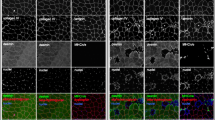Summary
Cross-sections (thickness 10 μm) of whole autopsied left and right anterior tibialis muscles of seven young previously healthy right-handed men (mean age 23 years, range 18–32 years) were prepared for light-microscope enzyme histochemistry. Muscle cross-sectional area and total number of fibres, mean fibre size (indirectly determined) and proportion of the different fibre types (type 1 and type 2 on basis of myofibrillar adenosine triphosphatase characteristics), in each muscle cross-section were determined. The analysis showed that the cross-sectional area of the left muscle was significantly larger (P<0.05), and the total number of fibres was significantly higher (P<0.05), than for the corresponding right muscle. There was no significant difference for the mean fibre size or the proportion of the two fibre types. The results imply that long-term asymmetrical low-level daily demands on muscles of the left and the right lower leg in right-handed individuals provide enough stimuli to induce an enlargement of the muscles on the left side, and that this enlargement is due to an increase in the number of muscle fibres (fibre hyperplasia). Calculations based on the data also explain why the underlying process of hyperplasia is difficult, or even impossible, to detect in standard muscle biopsies.
Similar content being viewed by others
References
Baumann H, Jäggi M, Soland F, Howald H, Schaub MC (1987) Exercise training induces transitions of myosin isoform subunits within histochemically typed human muscle fibres. Pflügers Arch 409:349–360
Belmont L, Birch HG (1963) Lateral dominance and right-left awareness in normal children. Child Dev 34:257–270
Bouchard C, Simoneu JA, Lortie G, Boulay MR, Marcotte M, Thibault MC (1986) Genetic effects in human skeletal muscle fibre type distribution and enzyme activities. Can J Physiol Pharmacol 64:1245–1251
Dickstein R, Pillar T, Hocherman S (1988) The contribution of vision and of sideness to responses of the ankle musculature to continuous movement of the base of support. Int J Neurosci 40:101–108
Fugl-Meyer AR, Gustavsson L, Burstedt Y (1980) Isokinetic and static plantar flexion characteristics. Eur J Appl Physiol 45:221–234
Fugl-Meyer AR, Eriksson A, Sjöström M, Söderström G (1982) Is muscle structure influenced by genetical or functional factors? A study of three forearm muscles. Acta Physiol Scand 114:277–281
Gorza L, Gundersen K, Lömo T, Schiaffino S, Westgaard RH (1988) Slow-to-fast transformation of denervated soleus muscles by chronic high-frequency stimulation in the rat. J Physiol (Lond) 402:627–649
Grace TG, Sweetster ER, Nelson MA, Ydens LR, Skipper BJ (1984) Isokinetic muscle imbalance and knee joint injuries. J Bone Joint Surg [Am] 66:734–740
Green HJ, Thomson JA, Daub WD, Houston ME, Ranney DA (1979) Fiber composition, fiber size and enzyme activities in vastus lateralis of elite athletes involved in high intensity exercise. Eur J Appl Physiol 41:109–117
Hageman PA, Gillespie DM, Hill LD (1988) Effects of speed and limb dominance on eccentric and concentric isokinetic testing of the knee. J Orthop Sports Phys Ther 10:59–65
Helliwell TR, Coakley J, Smith PEM, Edwards R (1987) The morphology and morphometry of the normal human tibialis anterior muscle. Neuropathol Appl Neurobiol 13:297–307
Henriksson-Larsén KB, Lexell J, Sjöström M (1983) Distribution of different fibre types in human skeletal muscles. Method for the preparation and analysis of cross-sections of whole tibialis anterior. Histochem J 15:167–178
Hsu JD, Slager UT, Swank SM, Robinson MH (1988) Idiopathic scoliosis: a clinical, morphometric, and histopathological correlation. J Pediatr Orthop 8:147–152
Larsson L, Tesch PA (1986) Motor unit fibre density in extremely hypertrophied skeletal muscles in man. Electrophysiological signs of muscle fibre hyperplasia. Eur J Appl Physiol 55:130–136
Lexell J, Henriksson-Larsen K, Sjöström M (1983) Distribution of different fibre types in human skeletal muscles: 2. A study of cross-sections of whole m. vastus lateralis. Acta Physiol Scand 117:115–122
Lexell J, Taylor C, Sjöström M (1988) What is the cause of the ageing atrophy? Total number, size and proportion of different fiber types studied in whole vastus lateralis muscle from 15 to 83 year old men. J Neurol Sci 84:275–294
Lexell J, Taylor C (1991) The fiber density; a fast and accurate way to estimate human muscle fiber areas. Muscle Nerve 14 (in press)
MacDougall JD, Sale DG, Elder GCB, Sutton JR (1982) Muscle ultrastructural characteristics of elite power lifters and bodybuilders. Eur J Appl Physiol 48:117–126
MacDougall JD, Sale DG, Alway SE, Sutton JR (1984) Muscle fiber number in biceps brachii in bodybuilders and control subjects. J Appl Physiol 57:1399–1403
Minotti JR, Johnson EC, Hudson TL, Sibbitt RR, Wise LE, Fukushima E, Icenogle MV (1989) Forearm metabolic asymmetry detected by 31P-NMR during submaximal exercise. J Appl Physiol 67:324–329
Neumann DA, Soderberg GL, Cook TM (1989) Electromyographic analysis of hip abductor musculature in healthy right-handed persons. Phys Ther 69:431–440
Pette D, Vrbova G (1985) Neural control of phenotypic expression in mammalian muscle. Muscle Nerve 8:676–689
Richardson JTE (1978) A factor analysis of self-reported handedness. Neuropsychologia 16:747–748
Salmons S, Henriksson J (1981) The adaptive response of skeletal muscle to increased use. Muscle Nerve 4:94–105
Schantz P, Randall-Fox E, Norgren P, Tydén A (1981) The relationship between the mean muscle fibre area and the muscle cross-sectional area of the thigh in subjects with large differences in thigh girth. Acta Physiol Scand 113:537–539
Tanaka M, McDonagh MJN, Davies CTM (1984) A comparison of the mechanical properties of the first dorsal interosseus in the dominant and non-dominant hand. Eur J Appl Physiol 53:17–20
Taylor NAS, Wilkinson JG (1986) Exercise-induced skeletal muscle growth. Hypertrophy or hyperplasia? Sports Med 3:190–200
Tesch P, Larsson L (1982) Muscle hypertrophy in bodybuilders. Eur J Appl Physiol 49:301–306
Wyatt MP, Edwards AM (1981) Comparison of quadriceps and hamstring torque values during isokinetic exercise. J Orthop Sports Phys Ther 3:57–61
Author information
Authors and Affiliations
Rights and permissions
About this article
Cite this article
Sjöström, M., Lexell, J., Eriksson, A. et al. Evidence of fibre hyperplasia in human skeletal muscles from healthy young men?. Europ. J. Appl. Physiol. 62, 301–304 (1991). https://doi.org/10.1007/BF00634963
Accepted:
Issue Date:
DOI: https://doi.org/10.1007/BF00634963




